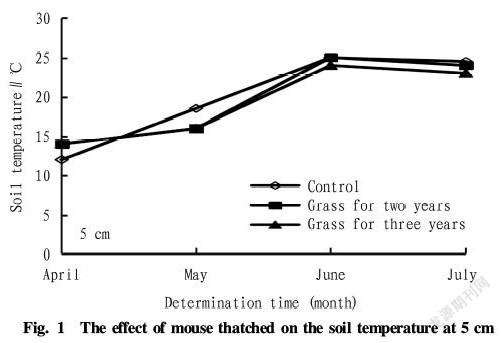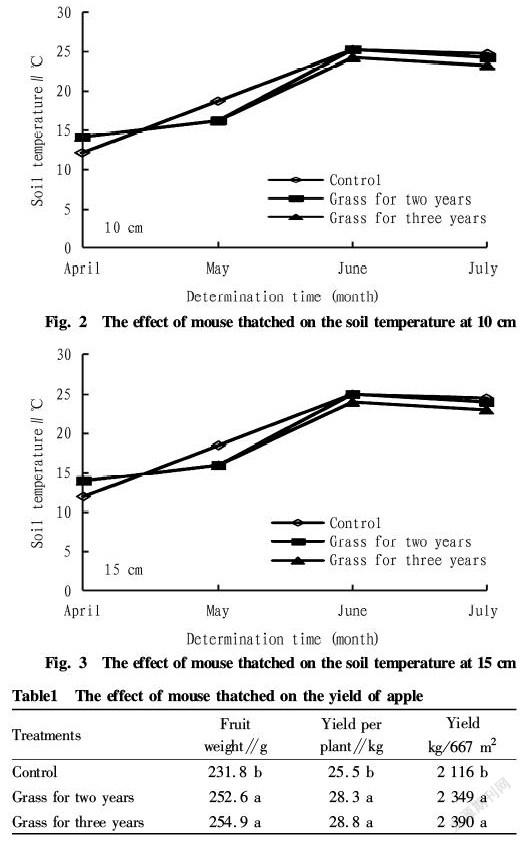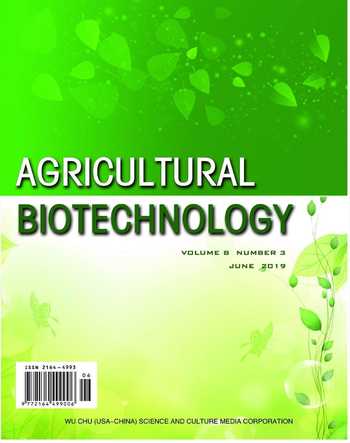Effects of Mouse Thatched on Soil Temperature Yield and Quality in Apple Orchard
2019-09-10YanhongLINaLIPeipingZHANGQiangshengSUNYaoSUNHongzhangWANG
Yanhong LI Na LI Peiping ZHANG Qiangsheng SUN Yao SUN Hongzhang WANG



Abstract [Objectives] This study was conducted to study the effect of mouse thatched on soil temperature, yield and quality in orchards.
[Methods] The response of orchard soil, yield and quality to sod culture was studied by comparisons of grassing for two years, three years and clean cultivation.
[Results] In April, the soil temperature in mouse thatched area was higher than that in clean cultivation area, and the temperature in the three years of sward was the highest. From May to July, the temperature in mouse thatched area was lower than that in clean cultivation area, and the temperature was lowest in the three years of sward. At the same time, the fruit yield and quality were improved. Averaged the two years, the yield of apple increased by 12%, and the contents of sugar, soluble solids and vitamin C and the firmness of the fruit were increased, and the total acid content was decreased by planting mouse thatched.
[Conclusions] Adjusting soil temperature in orchards by planting grass achieved the effects of promoting the activity of microorganisms, facilitating the growth of root system, increasing the yield and improving the quality.
Key words Apple orchard; Mouse thatched; Soil temperature; Yield; Quality
Soil can provide water and nutrients to fruit trees directly. Soil management is a very important link in the production of fruit trees, as well as the management basis of the whole fruit tree cultivation, which has an important impact on the growth and development of fruiter and fruit quality. At present, the main modes of soil management in orchards include clear tillage, grass mulching in orchards, green manure mulching, plastic film mulching, combination of agriculture and forest, grass growing and natural grass growing in orchards, etc. Sod culture is a practical, advanced and efficient soil management model[1-2], which has been proved to have the advantages of improving soil structure[3], improving soil fertility[4], preventing soil and water loss[5], adjusting orchard microclimate[6], inhibiting weed growth[7], etc., and has become one of the widely used orchard soil management models in many countries and regions in the world[8-9].
As early as in the 1960s, fruit production developed countries such as Europe, America and Japan have recognized the disadvantages and potential crisis brought by the management mode of clear cultivation. In the United States, orchard grass cultivation is considered to be one of the five important achievements in the development of the fruit industry[10]. In 1998, this technology was formally introduced and gradually popularized in China[11]. In addition, most of the existing researches are simple planting contrast tests, most of which are about the current situation and effect of orchard grass growing on soil physical properties, etc., mainly based on productive exploration tests, which effectively popularize orchard grass growing technology[12-15]. In this study, based on the characteristics of Yantai apple production orchards to discuss apple orchard soil temperature response to the mouse thatched and the effects of the mouse thatched on the yield and quality of apple, so as to provide reference for improving orchard soil management system and theoretical basis and technical guidance for healthy and continuous development of apple industry.
Materials and Methods
Test materials and design
6 year old Red Fuji was selected as a test material, and the plant spacing was 2 m×4 m. The growth trend of apple trees was uniform with good consistency. The experiment was conducted from march to November in 2016 and 2017. The contents of alkaline hydrolysis nitrogen, available phosphorus, available potassium, organic matter and pH were tested in 0-20 cm brown loam at 72.8 mg/kg, 41.0 mg/kg, 132.2 mg/kg, 11.4 g/kg and 5.9, respectively. The test grass was Japanese snow printing series, which was broadcasted on October 1 at the seeding rate of 1.0- 1.5 kg/667 m2 with a sowing depth of 3-4 cm in the manner of inter row grass. There were three treatments: clear tillage area as the control, grass growing for 2 years and grass growing for 3 years.
Determination of indicators and methods
Soil temperature: From April to July, at 14:00 on the 15 th , a high precision right angle glass thermometer with spherical corner (accurate to 0.5 degree) was adopted to observe the soil temperature at 5, 10 and 15 cm under the surface of different treatment areas continuously.
Yield: Five representative plants were selected for each treatment after fruit ripening in October. Two apples from 5 directions of east, west, south, north and middle were randomly selected in each tree, with a height of 1.3-1.5 m. A total of 50 fruits were selected. Yield per plant and yield per unit area were calculated based on average fruit weight, number of fruit per plant and planting density.
Fruit quality: 20 individual fruits were randomly selected after harvest, and the soluble solids were determined by PR 100 digital sugar meter. Fruit hardness was measured by an Italian FT327 fruit hardness tester. Vitamin C content was determined by titration with potassium iodate, and total acid was determined by titration with sodium hydroxide. The determination of each index was repeated 3 times.
Data analysis
DPS 6.55 software was used for data analysis, and LSD was used for mean significance test. Microsoft Excel 2003 was used to draw.
Results and Analysis
Effects of mouse thatched on soil temperature in apple orchard
It can be seen from Fig. 1 Fig.3 that the mouse thatched can regulate the temperature at different depths of the soil. Compared with the control (clean cultivation) area, the soil temperature of mouse thatched area was increased in April, soil temperatures of various layers were characterized by: grass for three years > grass for two years > control. The temperatures of 5, 10 and 15 cm in grass for 3 years were higher than those of the control by 2.5, 4.5 and 2.0 ℃, respectively, increased by 13.9%, 37.5% and 16.7%, respectively. Mouse thatched reduced the apple orchard soil temperature from May to July, and the soil temperature determination results were as follows: control > grass for two years > grass for three years. The temperature difference between the three treatments was largest in May, and the temperatures of 5, 10 and 15 cm in grass for 3 years were lower than those of the control by 3.5, 3 and 2.5 ℃, respectively, reduced by 14.9%, 15.8% and 13.5%, respectively.
Effects of mouse thatched on apple yield
As can be seen from table 1, the fruit weight, yield per plant and apple yield of the grass area were significantly higher than those of the clear tillage area. In the second year of grass growing, the above three indicators were increased by 9%, 11% and 11% than those of the clear tillage area, respectively. In the third year of grass growing, the above three indicators were increased by 10%, 13% and 13% than those of the clear tillage area, respectively. There were no significant differences in fruit weight, yield per plant and yield per unit area between the second and third years.
Effects of mouse thatched on apple fruit quality
As can be seen from table 2, the planting of mouse thatched improved the quality of apple. Compared with the control (clear cultivation area), the sugar content, soluble solids, vitamin C content and pulp hardness of the fruit increased significantly, and the effect of mouse thatched on quality was more significant with the increase of years of planting grass. The above indexes of the apple that have been green for 2 years were increased by 11%, 5%, 6% and 2%, respectively, while those of the apple that have been green for 3 years were increased by 12%, 9%, 8% and 6%, respectively, compared with the control. The total acid content of fruit was reduced by 7% and 11% in two and three years, respectively.
Yanhong LI et al. Effects of Mouse Thatched on Soil Temperature, Yield and Quality in Apple Orchard
Discussion and Conclusions
The compound system of "soil herbage atmosphere" was formed in the orchard after growing mouse thatched grass, which changed the ecological factors such as light, heat, water and air near the ground and changed the environment of "soil atmosphere" in the orchard. The plant or dead plant covered the soil surface of the orchard from May to July, similar to an organic ground cover that can reduce the intense direct radiation to the soil in the burning day, thus reducing the soil temperature and water evaporation, and making the apple trees survive the hot summer safely. Studies on citrus showed that the surface and subsurface soil temperature and canopy air temperature were both reduced by grass cultivation in summer, so as to alleviate the adverse effects of high temperature and drought on the growth and development of citrus trees and fruits[16]. Studies on apple showed that the soil temperature of grass area was 1.7-2.6 ℃ lower than that of the control on 5-25 cm in hot seasons, and sod culture has positive effects on reducing soil moisture evaporation, resisting drought and conserving moisture, and maintaining normal growth and development of trees[17]. Studies on grape showed that inter row grass could regulate the soil temperature of surface and near surface soil, and the highest temperature could reduce 5.7-7.3 ℃, which was conducive to the growth of root system[18]. In this study, the soil temperature in the mouse thatched area was higher than that in the clear tillage area in April, and the highest temperature was in the three years of grass growing, followed by two years of grass growing, and finally in the clear tillage area. The temperature in the mouse thatched area was lower than that in the clear tillage area from May to July, and the lowest temperature was in the grass growing area for 3 years, followed by the grass growing area for 2 years, and finally in the clear plowing area. It showed that the mouse thatched had the function of regulating soil temperature, and the herbage formed a layer of barrier layer of heat exchange between soil and atmosphere on the surface, which not only reduces the emission of soil heat into the atmosphere, but also reduces the solar radiation on the soil surface, which was consistent with the previous research results.
Studies on inter row herbage cultivation of four herbage species in upland apple orchards showed that the yield of sward orchard increased by 12.78%-31.57% compared with that in clear plowing areas, but the effects of different herbage species on the yield were different[19]. Studies on vineyards have shown that shallow root grasses intensified competition for water and fertilizer resources, resulting in reduced production of grapes[20]. Therefore, similar combinations should be avoided in production. In this experiment, the yields of the 2 year and 3 year mouse thatched area were increased by 11% and 13%, respectively. Many studies have proved that grass cultivation is beneficial to the improvement of fruit quality. Deng et al.[21] reported that fruit soluble solid content increased by 11.3%, hardness increased by 9.2%, and fruit coloring index increased by 35.0%, when intercropping apple tree and white clover for 6 continuous years in dry land of loess plateau. Sod culture can also reduce citric acid content of citrus and improve fruit quality[22]. It was found that sod culture in vineyard could improve the quality of wine by increasing the total content of free amino acid in grape[23]. In this study, the sugar content, soluble solids, Vitamin C content and pulp hardness of apple fruits were increased by 11.5%, 7%, 7% and 4% compared with that in clear tillage area after planting of mouse thatched, respectively, while the total acid content decreased by 9% on average. This might be due to that the adjustment of soil temperature in orchards after planting grass achieved the effects of promoting the activity of microorganisms, facilitating the growth of root system, increasing the yield and improving the quality.
References
[1] DRINKWATER LE, WAGONER P. Legume based cropping systems have reduced carbon and nitrogen losses[J]. Nature, 1998, 396(6708): 262-265.
[2] ZHANG W, ZHU YZ, LI GC. Practical and efficient orchard soil management method orchard grass growing method[J]. New Agricultural Technology, 2003 (4):7-8. (in Chinese)
[3] LI HK, ZHANG GJ, ZHAO ZY, et al. Effects of different herbage on soil quality characteristics of non irrigated apple orchard in Weibei loess plateau[J]. Scientia Agricultura Sinica, 2008, 41(7): 2070-2076. (in Chinese)
[4] PAN XJ, ZHANG W, FAN WG, et al. Effects of sod culture and intercropping green manure on the soil nutrient, enzyme activities and microorganisms in bonsai citrus[J]. Acta Horticulturae Sinica, 2010, 37 (8): 1235-1240. (in Chinese)
[5] ZHANG CL, CHEN DB, LIU SY. Effects of soil and water conservation by planting herbals on the sloping red soil land of an orchard[J]. Acta Agrestia Sinica, 2006, 14(4): 365-369. (in Chinese)
[6] ZHANG WL, WU BM, MA HX, et al. Effect of growing grass on ecological environment and fruit quality in apricot orchards in dry regions of high altitude with cool or cold conditions[J]. Northern Horticulture, 2014(06):27-31. (in Chinese)
[7] ZHANG H, LIAO GX, MA LJ, et al. Effect of Clover Plantation on Weeds Community and Species Diversity in Orchard[J]. Chinese Agricultural Science Bulletin, 2017, 34(32)(in Chinese)
[8] DENG FC. Ecological Effect and application prospect of growing grass in orchard[J]. Northern Horticulture, 2009 (1): 133-136. (in Chinese)
[9] NEILSEN GH, HOGUE EJ. Long term effects of orchard soil management on tree vigor and extractable soil nutrients[J]. Canadian Journal of Soil Science, 1992, 72(4): 617-621.
[10] BILL LUCE. Five most important developments[J]. West Fruit Grower, 2004, 124(10): 13.
[11] HE Q. To promote the green food orchard grass technology[J]. Chinese food and nutrition, 1998 (6):40. (in Chinese)
[12] DENG YL, CHEN ZJ, LIU SQ, et al. Effects of ecological agricultural system comprising of pear ryegrass and goat[J]. Journal of Soil and Water Conservation, 2003, 17(2): 24-27. (in Chinese)
[13] FENG CL, CHEN JP, ZHANG LS. Influence of sod culture to the ecology environment of Fuji orchard[J]. Acta Agriculturae Boreali occidentalis Sinica, 2007, 16(4): 134-137. (in Chinese)
[14] LI YH, SHI DY, ZHANG PP, et al. The Effect of Mouse thatched on The Soil Physical Characteristics and Yield of Apple [J]. China Fruits, 2017(4): 17-19. (in Chinese)
[15] LI HK, ZHAO ZY, ZHANG GJ. Effects of planting different herbage on soil fertility of apple orchard in Weibei areas[J]. Journal of Northwest Forestry University, 2004, 19(2): 31-34. (in Chinese)
[16] LI GH. The application of bahia grass (Paspalum notatum) to sod culture and grass system in south orchard [J]. Ecological Science, 2001, 20(1): 70-74. (in Chinese)
[17] MENG L, YU LH, MAO PC. Effects of Inter planting cocksfoot and white clover as cover crops on the microclimate of apple orchard[J]. Pratacultural Science, 2009, 26(8): 132-136. (in Chinese)
[18] HUI ZM, LI H, ZHANG ZW, et al. Effect of green covering on vineyard microclimate and wine quality[J]. Journal of Northwest A & F University (Natural Science Edition), 2004, 32(10) : 33-37. (in Chinese)
[19] HAO SY, LIU HD, NIU JL, et al. Effects of herbage mulching to the apple yield and soil water and other soil physical properties in the loess plateau[J]. Soil and Fertilizer Sciences in China, 2003(1): 25-27. (in Chinese)
[20] HOGUE EJ, NEILSEN GH. Orchard floor vegetation management[M]. Horticultural Reviews, 1987.
[21] Deng FC. Research on growing grass in apple orchard in Weibei upland[D]. Northwest A and F University, 2005. (in Chinese)
[22] ZENG M, LI DG, XIONG BQ, et al. Effects of sod culture management in citrus orchard on AM infection in citrus roots and on fruit quality[J]. Journal of Southwest University (Natural Science Edition), 2004, 26(2): 105-107 . (in Chinese)
[23] LI GH, YI HL. Influence of sod culture on the soil water content, effect of soil nutrients, fruit yield and quality in citrus orchard[J]. Chinese Journal of Eco Agriculture, 2005, 13(2): 161-163. (in Chinese)
杂志排行
农业生物技术(英文版)的其它文章
- Study on Chemical Composition of the Ethyl Acetate Extract of Pratia
- Effects of Different Selenium Fertilizer Types on Selenium Content and Quality of “Lingfeng” Grapes
- Protoplast Culture and Its Application in Fruit Breeding
- Indexes of Tree Structure of Cylindrical Pear Orchards at the Sapling Stage
- Carbon Storage and Distribution of the Mature Pinus massoniana Plantation in Northwest Guangxi
- Pollution and Quality Control of Mycotoxins in Foods and Feeds
